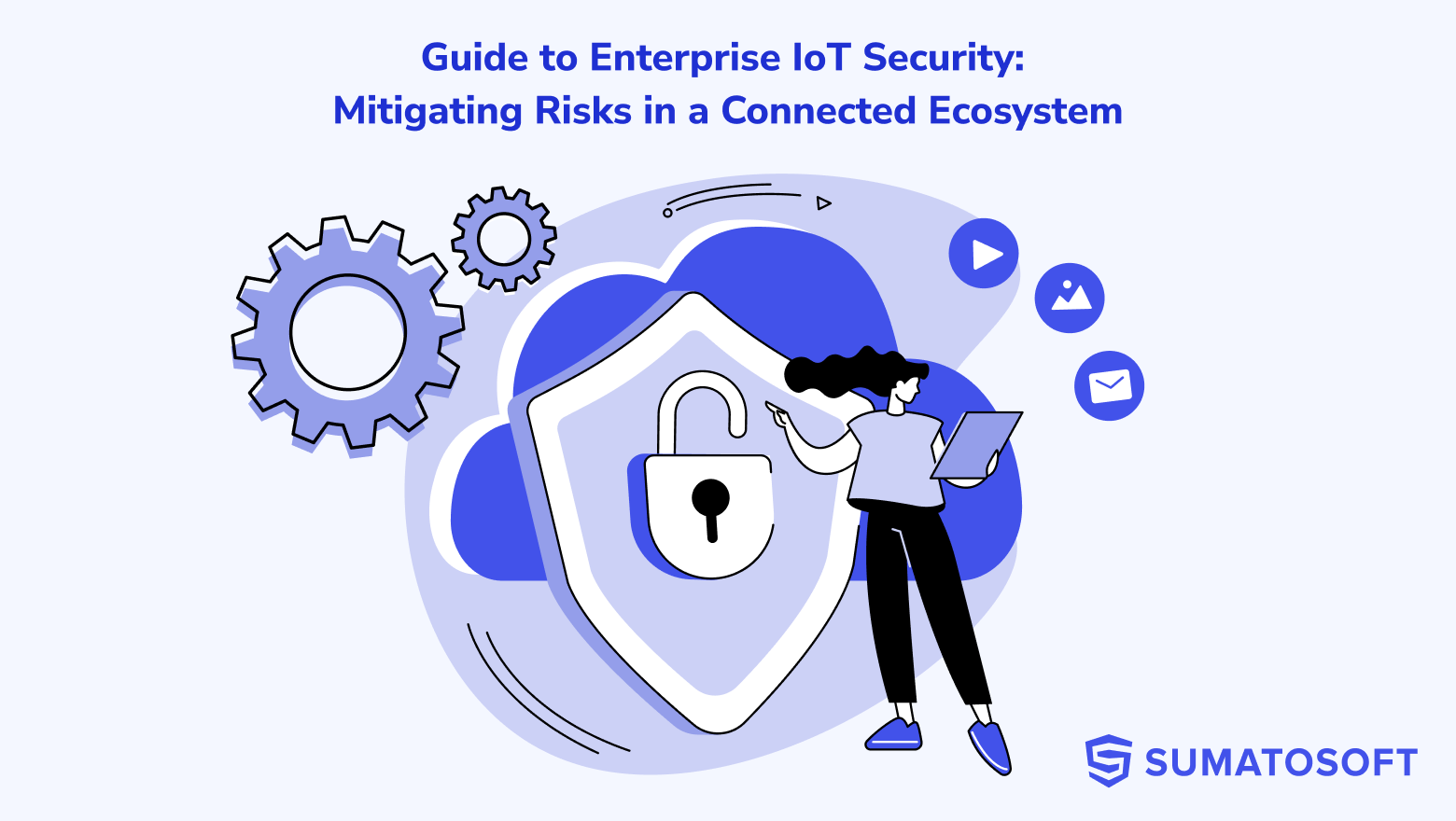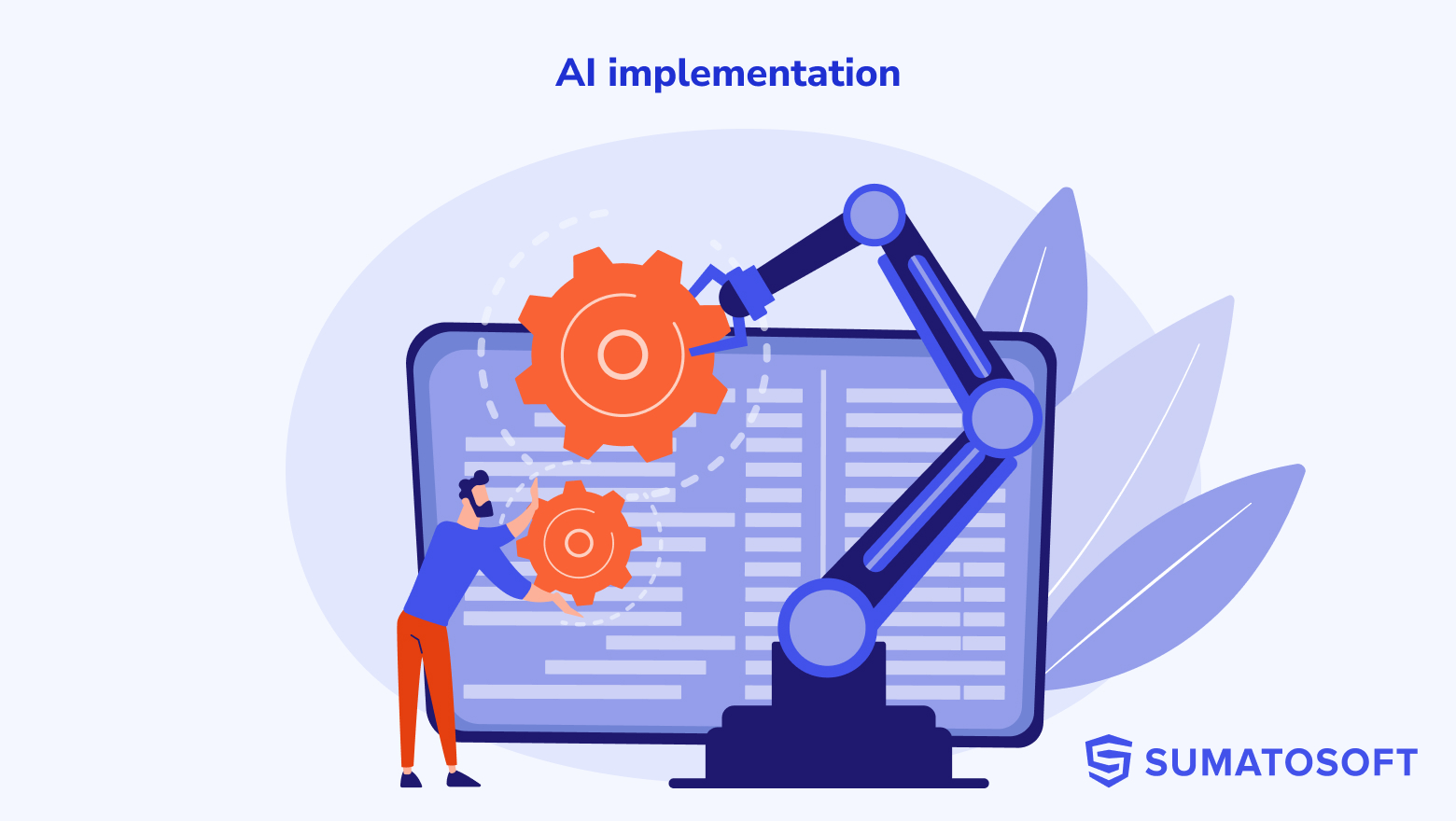Outsource Web Development: Decision-Making Framework 2025
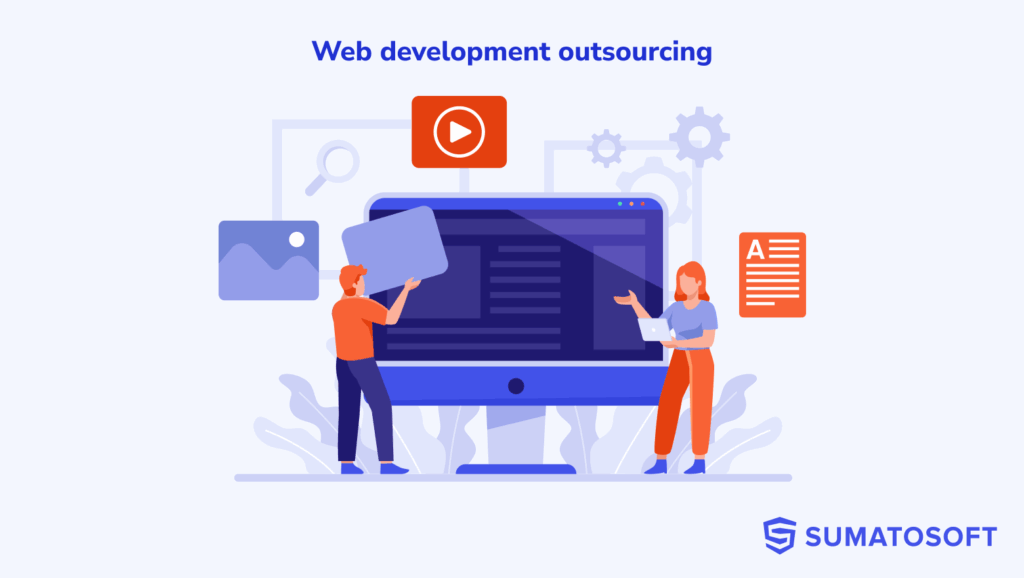
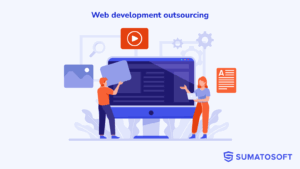
What does web development outsourcing look like in 2025?
How can businesses use it wisely to unlock real value?
The outsourcing landscape has evolved in recent years. That’s why we wrote this overview: to help business leaders, startup founders, CTOs, and product owners understand how outsourcing works today and how to use it to their advantage.
To do so, we analyzed three of the most recent and respected reports:
- Global outsourcing survey 2024 from Deloitte.
- Global outsourcing survey 2022 from Deloitte.
Over the past 13 years, we’ve closely observed the market as both active participants and web development service providers. We united these observations in several guides with a treasure trove of helpful information. These guides are:
- Software Outsourcing Costs [2025 updated].
- IT Outsourcing Overview in 2025.
- IT Project Outsourcing – general guide.
This framework brings it all together. It shows when outsourcing makes sense, how to avoid common traps, and how to turn a web development partnership into a source of speed, flexibility, and long-term business value.
Executive Summary
- 2025 is an optimal time to outsource web development, combining high developer availability, mature vendor capabilities, and AI-powered productivity while retaining 40–70% cost advantages over in-house teams.
- Cost savings are no longer the main driver; companies primarily outsource to access specialized talent in AI, cybersecurity, and data engineering, improve delivery quality, and accelerate time to market.
- Leading vendors have adopted outcome-based contracts, AI-augmented workflows, and hybrid sourcing models, enabling results comparable to in-house delivery.
- AI is widely deployed but not fully optimized; 92% of companies use AI tools, yet less than half see clear productivity gains, making vendor maturity critical.
- Outsourcing rates have increased 7–20% in recent years due to inflation and talent shortages, but remain significantly lower than local hiring costs.
- Regions like Eastern Europe and Latin America offer strong value, while India and Southeast Asia maintain the lowest rates with evolving quality standards.
- Outsourcing works best when companies need hard-to-find expertise, faster scaling, or transformation support, and is less suitable for projects involving sensitive IP or complex regulatory obligations.
- Integrated governance across procurement, operations, vendor management, finance, and the provider is essential, shifting outsourcing from transactional engagements to strategic partnerships.
- Flexible, shorter contracts with milestone-based or outcome-based pricing models are now the standard, supporting agility and accountability.
- Companies that combine mature partners, clear governance, and outcome-focused delivery models will leverage outsourcing as a driver of innovation, resilience, and growth.
The Purpose of This Framework
This framework exists for one reason: to help business leaders make confident decisions about outsourcing web development in 2025.
The market is noisy, full of vendors, mixed advice, and evolving models. That’s why we created this guide: to bring clarity. This framework could help to answer the following questions:
- How does the outsourcing market look in 2025?
- When should you outsource?
- How much does web development outsourcing cost in different regions?
- How do you choose the right vendor?
- What risks should you prepare for?
- And how do you ensure your outsourcing efforts drive real business results?
And much more.
Is Now a Good Time to Outsource?
Yes. 2025 is one of the most favorable times in recent years to outsource web development. The market offers a rare mix of economic pressure (which makes cost-saving strategies essential), increased developer availability, and matured vendor quality – all while AI boosts productivity without replacing human expertise.
Economic Pressures Favor Outsourcing
With recession risks rising (~61% odds in the U.S.), companies are cutting fixed costs. Outsourcing remains a proven way to reduce overhead while continuing digital initiatives. Just like in 2008, businesses now shrink in-house teams and shift work to external partners to stay agile and lean.
Talent Access Is High – and Strategic
Tech layoffs in 2022–2023 have made high-quality developers more available on contract. At the same time, global demand for specialized skills (AI, ML, cybersecurity) still far outpaces supply. Outsourcing lets you tap into rare expertise quickly – especially across borders.
Quality Has Caught Up
The outsourcing market has matured. Leading vendors now deliver work that rivals in-house teams, thanks to stronger processes, certifications, and outcome-based models. If you vet carefully, quality is no longer a compromise.
AI Is a Multiplier, Not a Replacement
Worried AI will make outsourcing irrelevant? Don’t be. Vendors use AI tools (like Copilot or automated testing) to improve speed – but skilled developers are still essential. Outsourcing now gives you access to AI-augmented delivery, not just cheaper labor.
If you choose the right partner and define clear goals, now is an excellent time to start.
Why Outsource Web Development in 2025
Outsourcing web development has shifted from a tactical move to a strategic enabler. It’s no longer just about cutting costs – it’s about gaining access to talent, accelerating innovation, and building flexible digital capabilities that match the pace of change.
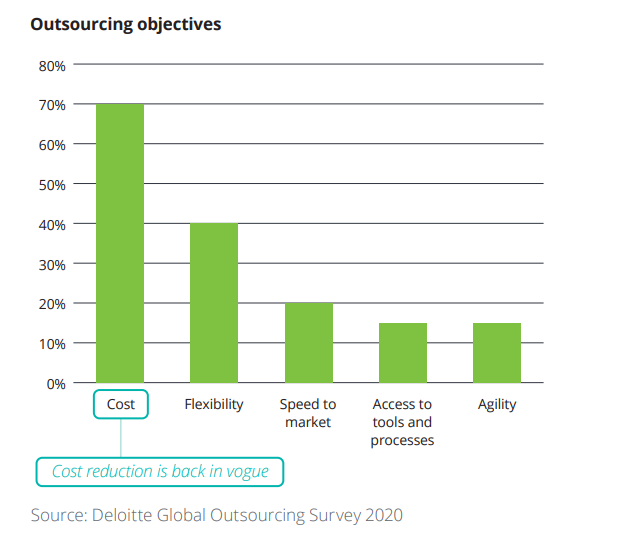
Back in 2020, 70% of companies cited cost savings as the primary reason to outsource. By 2024, that number dropped to 34%. Today, the top reasons to outsource include:
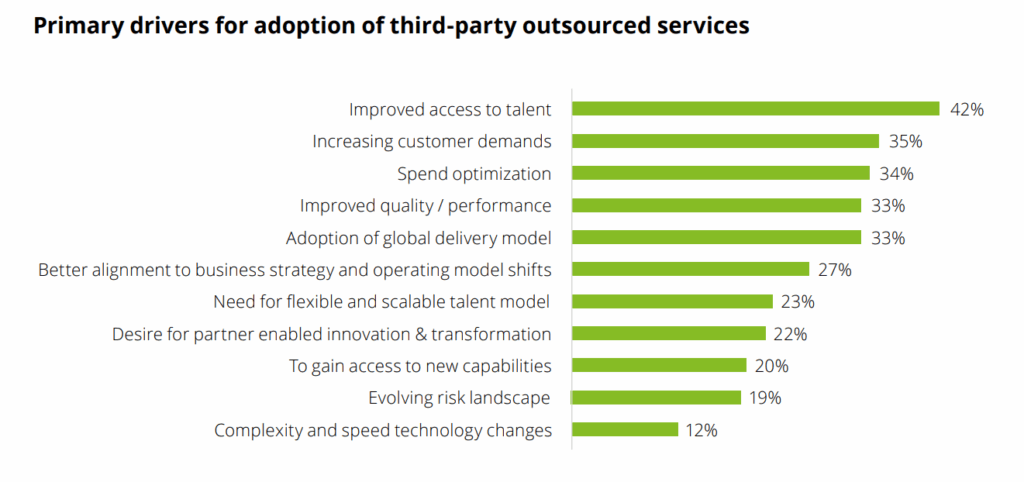
- Access to hard-to-find talent (42%) – especially in AI, cybersecurity, and data engineering.
- Improved quality and performance (33%) – through mature processes and proven delivery models.
- Scalable teams and flexible capacity (23%) – scale up or down without internal overhead.
- Faster time to market – essential in short tech cycles and competitive industries.
- Innovation through partnerships – modern vendors don’t just execute, they co-create
Companies that adopt modern delivery models like Operate Services and outcome-based contracts report up to 88% higher satisfaction compared to those using legacy staff augmentation. These models help align outsourcing with business strategy – not just delivery timelines.
Outsourcing also enables:
- Cost reduction of 20–75% vs. in-house development.
- Focus on core business, freeing up internal teams.
- Access to global expertise, tools, and frameworks.
- Faster transformation, especially in regulated or fast-moving sectors.
- Improved customer experience, with vendors contributing directly to front-end performance.
Whether you’re building a digital product from scratch or modernizing legacy systems, outsourcing in 2025 offers more than capacity – it offers a way to compete, scale, and innovate without delay.
Overview of Web Development Outsourcing in 2025
Web development outsourcing has entered a new era. What was once a transactional, cost-cutting tactic has become a strategic lever for growth, innovation, and resilience.
In 2025, businesses no longer rely on a single outsourcing model. Instead, they orchestrate ecosystems that combine traditional outsourcing, insourcing, Global In-house Centers (GICs), and AI-augmented digital teams. This multidimensional approach reflects a broader shift: from reducing costs to building capabilities.
The key driver today is no longer price – it’s talent. According to Deloitte, 42% of companies outsource primarily to access specialized skills. These include AI/ML, cybersecurity, and advanced frontend frameworks – areas where internal hiring is slow, costly, or simply unrealistic.
Other defining shifts include:
- Outcome-based engagements: 67% of executives now use outsourcing models focused on results – not just hours logged. These relationships are built around KPIs, co-innovation, and measurable business value.
- Front-office outsourcing: Marketing, R&D, and customer-facing development are no longer off-limits. Over 50% of organizations now outsource beyond the back office.
- AI-powered delivery: 92% of companies are using or planning to use AI in outsourcing. Vendors are expected to bring AI-enabled coding, testing, and productivity tools as a baseline – not a bonus.
- Strategic partnerships: Companies are moving away from vendor-as-contractor models. Today, successful outsourcing is built on shared governance, transparency, and long-term alignment.
As a result, the line between “outsourcing” and “core operations” is fading. The best external teams now function as extensions of in-house teams – fully integrated into delivery pipelines, innovation cycles, and even customer experience strategies.
Outsourcing in 2025 isn’t about saving money on developers. It’s about scaling capabilities without scaling overhead, accelerating time-to-market, and building a more agile business – fast.
Industry Trends and Statistics
The global outsourcing market is not just growing – it’s evolving fast. In 2025, web development outsourcing reflects broader shifts in business, technology, and talent availability. Below are the key trends shaping this space.
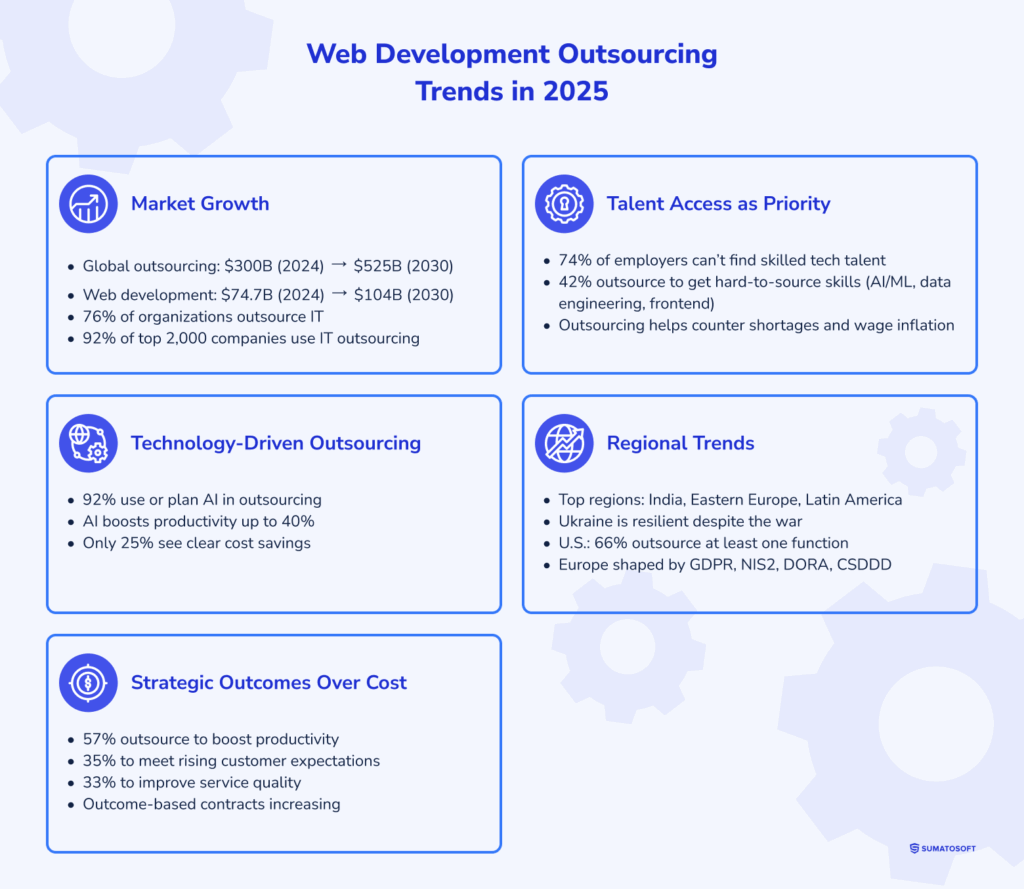
Trend #1 Market Growth
- The global outsourcing industry was valued at $300B in 2024 and is projected to reach $525B by 2030 (CAGR ~9.8%).
- Web development services alone are expected to grow from $74.7B in 2025 to $104B by 2030.
- 76% of organizations now outsource IT functions, including web development.
- Among the world’s 2,000 largest companies, 92% use some form of IT outsourcing.
Trend #2 Talent Access As The New Priority
- 74% of employers globally report difficulty finding skilled tech talent.
- 42% of businesses outsource specifically to access hard-to-source skills – including AI/ML, data engineering, and modern frontend frameworks.
- Outsourcing has become a direct response to the global developer shortage and wage inflation.
Trend #3 Technology-Driven Outsourcing
- AI adoption is now standard: 92% of companies already use or plan to use AI in outsourcing.
- Leading vendors embed AI in their workflows: code generation, automated testing, CI/CD, and project tracking.
- AI boosts developer productivity by up to 40%, according to McKinsey – but only 25% of companies currently see clear cost reductions, revealing a maturity gap.
Trend #4 Regional Trends
- India, Eastern Europe, and Latin America continue to lead in volume and capability.
- Ukraine remains strong despite wartime disruptions – but many Clients have diversified to neighboring regions.
- U.S. market: 66% of companies outsource at least one business function; demand is especially high among startups and growth-stage firms.
- European market: Growth continues, but is shaped by regulation (GDPR, NIS2, DORA, and the new CSDDD directive under the Green Deal).
Trend #5 Strategic Outcomes Over Cost
- Cost savings are no longer the sole driver:
- 57% outsource to increase productivity
- 35% to meet rising customer expectations
- 33% to improve service quality
- Outcome-based contracts are rising. Clients want real results – not just hours worked.
In 2025, outsourcing is less about handing off tasks and more about building high-performance delivery ecosystems. The numbers show a mature, competitive market – one where access to talent, speed, and innovation matter more than ever.
When Outsourcing Makes Sense (and When It Doesn’t)
Outsourcing web development in 2025 is no longer a yes-or-no decision. It’s a strategic tool – one that delivers tremendous value in the right context, and serious setbacks in the wrong one. This section outlines clear scenarios when outsourcing drives results, and cases where it might compromise control, speed, or innovation.
When Outsourcing Makes Sense
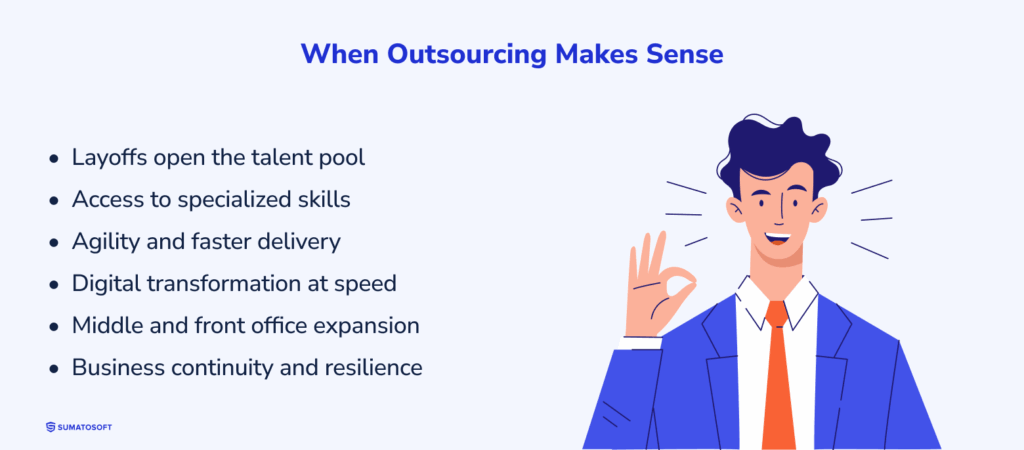
Layoffs Open The Talent Pool
The freelance and contract developer market grew after technology companies conducted large-scale layoffs throughout 2022-2023. The outsourcing ecosystem became more favorable for finding capable vendors during 2025 because many skilled engineers joined after internal hiring restrictions or high costs became prohibitive.
Access To Specialized Skills
AI and data skills along with cybersecurity expertise and advanced front-end frameworks continue to be highly sought after but remain scarce in the market. Companies can use outsourcing to fill their capability gaps quickly because it eliminates the need for lengthy internal hiring and training processes.
Agility And Faster Delivery
The ability to adjust staffing levels according to demand peaks and valleys exists through outsourcing because it eliminates unnecessary expenses during periods of reduction. Time zone delivery enables continuous work which reduces product release timelines particularly beneficial for startups and product teams working against deadlines.
Digital Transformation At Speed
Digital transformation initiatives face challenges because organizations lack both necessary tools and skilled personnel and sufficient bandwidth to execute system modernization quickly. Outsourcing provides organizations with direct access to teams who can quickly and reliably deploy cloud-based and automated AI-based solutions.
Middle And Front Office Expansion
Outsourcing previously limited to back-office functions now extends its support to sales and marketing operations as well as research and development activities. Providers who specialize in vertical markets can provide quantifiable improvements to customer interactions and data insights and revenue growth capabilities.
Business Continuity And Resilience
Uncertain market conditions make outsourcing an operational flexibility option. The delivery models of providers which combine hybrid and global operations ensure business continuity during disruptions such as pandemics and geopolitical events.
When Outsourcing Doesn’t Make Sense
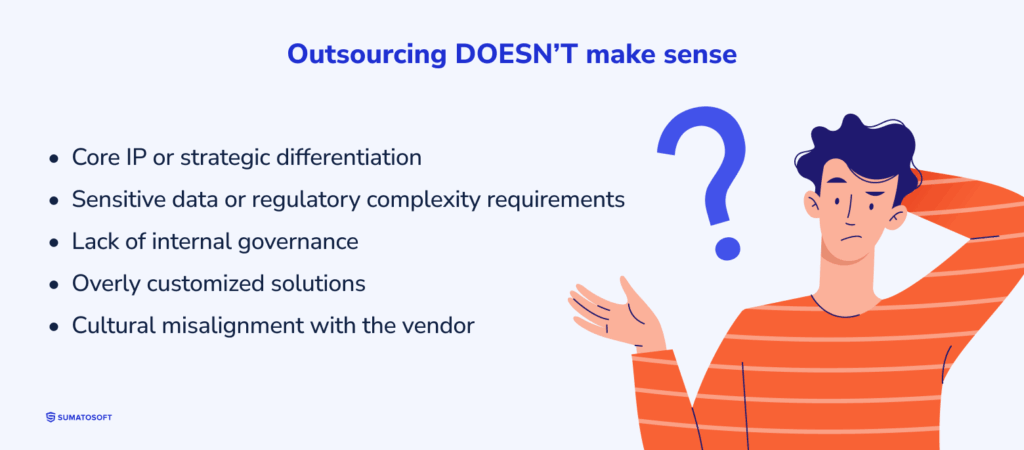
Core IP Or Strategic Differentiation
The risk of outsourcing projects that stem from core company values becomes high when they involve proprietary technology or algorithms or customer experience development. These domains require complete ownership from within the organization together with strict confidentiality standards and extended knowledge maintenance.
Sensitive Data Or Regulatory Complexity
Outsourcing systems that process highly regulated data such as financial or healthcare or government platforms will typically increase your compliance requirements. The absence of data privacy measures and security protocols and audit transparency standards creates expensive risks for your organization.
Lack Of Internal Governance
Complex outcome-driven work outsourcing needs organizations to establish mature internal structures which include contract management and vendor performance monitoring and cross-functional alignment. The absence of these structures leads to value leakage and rework and failed expectations.
Overly Customized Solutions
Highly customized outsourcing arrangements tend to produce negative results. Custom workflows inflate costs and slow delivery. Standardized engagements with proper scope deliver superior results through faster delivery at lower costs.
Cultural Misalignment
The combination of different communication styles and business norms between outsourcing partners creates misalignment which destroys project momentum. The success of agile teams depends on cultural fit and time zone overlap and collaboration rhythm especially when working together.
Strategic Balance: Outsource What Supports, Insource What Defines
In 2025, leading companies treat outsourcing not as a blanket solution, but as a strategic mix. They outsource to scale fast, access scarce skills, or extend delivery reach – and they insource to protect strategic IP, ensure governance, or build internal expertise. Many also adopt hybrid models like Global In-house Centers (GICs) or Build-Operate-Transfer (BOTT) frameworks to blend control and flexibility.
The key: align your outsourcing decisions with business priorities, risk tolerance, and capability gaps. The more intentional the approach – the higher the return.
Cost Benchmarks and Pricing Models
Outsourcing web development in 2025 remains one of the most effective ways to reduce costs – even though prices have risen. The hourly rate for developers varies widely depending on region, experience level, and project type. While outsourcing is no longer “dirt cheap,” it still offers 40–70% savings compared to onshore development in high-cost regions like the U.S. or Western Europe.
Regional Cost Breakdown
Clients can still find excellent value by choosing the right location. For example, a senior developer in the U.S. might cost $75–$135/hour, while a similarly skilled engineer in Eastern Europe can be hired for $35–$50/hour. Asia (especially India and Southeast Asia) remains the most affordable region, though rates in major cities are rising due to wage inflation.
Meanwhile, Latin America offers a strong balance between cost and time zone alignment, with typical rates between $45 and $85/hour. Eastern Europe continues to thrive despite geopolitical instability, offering high-quality engineers at a lower cost than Western markets.
The table below summarizes average hourly rates for custom web/software development in major regions, along with qualitative attributes like typical quality, communication, and time zone alignment for Clients:
Table – Regional Comparison of Outsourcing Rates and Attributes
| Region | Typical Developer Rates (USD/hour) | Quality & Talent Pool | Communication & Culture | Time Zone Fit (with Client) |
|---|---|---|---|---|
| North America | Good English proficiency (widespread in IT); moderate cultural alignment with Western Europe/US. Communication is generally smooth, though minor cultural differences exist. | World-class talent; highest quality and experience level. | Native English; very familiar with Western business culture. | Full overlap for US Clients (onshore); poor overlap for European/Asian Clients due to 5–10h time difference. |
| Western Europe | $60–$120/hr | Strong developer skill base, similar to North America. | Excellent English proficiency; culturally aligned with Western norms. | Full overlap for European Union Clients; limited overlap for US (5–8h ahead of US time). |
| Eastern Europe | ~$40–$80/hr | Highly skilled, well-educated engineers; renowned for quality code (esp. in complex fields like AI & fintech). Large tech talent pool in countries like Poland, Ukraine, Romania. | Moderate overlap: 1–3h time difference with Western Europe (very convenient); ~5–8h ahead of the U.S., allowing a few overlapping work hours. | Moderate overlap: 1–3h time difference with Western Europe (very convenient); ~5–8h ahead of U.S., allowing a few overlapping work hours. |
| India (South Asia) | ~$20–$50/hr (very wide range by experience) | Vast talent pool (4M+ IT professionals); capable engineers for both routine and advanced projects. Quality can be excellent with top firms but varies widely (ensure vetting for complex work). | English is an official business language – many developers have strong English skills. However, cultural differences and communication styles can pose challenges if not managed (e.g. differing work styles or reluctance to give bad news). | Minimal overlap with US (10–12h ahead; requires early/late calls); partial overlap with Europe (4–5h ahead of EU). Teams often adjust shift timings for better overlap when needed. |
| Southeast Asia (e.g. Vietnam, Philippines) | ~$18–$45/hr (similar to India) | Growing talent pools with improving skills. Often deliver cost-effective solutions, though average code quality may be lower on very complex projects. Notable strengths in front-end and mobile development. | English proficiency varies by country (high in Philippines and Singapore; moderate in others). Cultural distance from Western Clients is a consideration, but many teams adapt well with experience. | Minimal overlap with US (GMT+7 to +11 zones); partial overlap with Europe (e.g. Southeast Asia is ~6–7h ahead of UK). Near full alignment for Clients in East Asia/Pacific. |
| Latin America | ~$45–$85/hr (juniors from ~$30/hr) | Solid and expanding talent pool, though smaller than Asia/Europe. Quality of work is generally high for experienced teams, with familiarity in modern methodologies (Agile, DevOps). Top firms produce work on par with U.S. standards. | Good cultural compatibility with North America. English proficiency is moderate to high in tech communities (varies by country and education). Proximity facilitates easier communication and even occasional in-person collaboration. | Excellent overlap with U.S./Canada (same or similar time zones). Partial overlap with Western Europe (LatAm is ~5 hours behind Europe, so mornings in LatAm align with Europe’s afternoon). |
Despite rapid inflation over the past two years, outsourcing is still a cost-effective option – just not as cheap as it used to be. Between 2022 and 2023, many IT vendors raised their rates by 7–20%, including top providers like AWS and Adobe. A global talent shortage, wage inflation, and soaring demand for developers in high-stakes domains like AI, cybersecurity, and data engineering drove this price growth.
Eastern Europe, in particular, saw notable rate increases in popular hubs like Poland and the Czech Republic. In contrast, India and Southeast Asia kept prices relatively stable. The result? Outsourcing is no longer “cheap,” but it’s still 40–60% cheaper than hiring locally in North America or Western Europe. The financial case for outsourcing holds – but expectations around pricing need to be recalibrated.
Pricing Models
Beyond geography, pricing structures play a major role in cost control and flexibility. The most common models include:
- Fixed price – ideal for well-defined scopes. You pay a set fee (e.g., $25K for an MVP), with lower risk but less flexibility.
- Time & materials (hourly) – used when the scope is evolving. Offers flexibility but requires careful monitoring.
- Milestone-based – links payments to deliverables (e.g., $5K per module), combining structure with adaptability.
- Outcome-based – increasingly used in mature partnerships. Instead of billing hours, the vendor is paid for achieving results – such as on-time delivery, performance metrics, or business KPIs.
- As-a-service models – vendors offer fully packaged capabilities (e.g., “web platform as a service”) billed by usage.
These models are often combined. For example, a discovery phase might be fixed price, development billed hourly, and delivery tied to outcomes.
AI-Driven Delivery: New Value, Same Cost
AI is transforming how vendors deliver software – even if it hasn’t lowered the price per hour. Many outsourcing firms now use AI-powered tools such as:
- code generators (e.g., GitHub Copilot);
- automated QA and test coverage;
- CI/CD pipelines with predictive deployment.
According to McKinsey, these tools can boost developer productivity by up to 40%. However, only 25% of Clients report actual cost reductions due to AI. Fewer than half say they’ve seen clear productivity gains reflected in billing or delivery speed.
This reflects a maturity gap: while AI is widespread, most vendors haven’t yet optimized their workflows enough to pass those gains to Clients through lower costs or shorter timelines.
Still, for savvy buyers, there is a hidden advantage: you may get more value per hour. AI-ready vendors can deliver the same scope faster and with fewer bugs – even if their rate card hasn’t changed. In that sense, the cost per hour hasn’t dropped, but the output per hour has risen.
A Worth-Mentioning Trend in Contracting
Deloitte and KPMG both highlight a major shift toward outcome-based contracts. In these arrangements, providers are rewarded not for time spent, but for value delivered. This approach aligns incentives, encourages efficiency (especially with AI tools in play), and helps Clients manage risks more effectively.
At the same time, modern contracts are becoming shorter (3–5 years vs. 7+) and more modular. Clients increasingly mix models – combining fixed-price modules, capped T&M, and gain-sharing clauses. This flexibility allows companies to adjust as priorities shift.
To adopt these models successfully, Clients need mature governance structures: clear KPIs, tracking systems, and accountability mechanisms. Without them, value can leak – even in an otherwise strong vendor relationship.
Market Pricing: Overpriced or Underpriced for Clients?
Despite recent rate increases, the outsourcing market in 2025 feels overpriced compared to its own historical costs but remains underpriced relative to onshore hiring.
Cost Efficiency vs. Rising Rates
For Clients in high-cost regions, outsourcing remains a cost-effective option despite recent price increases. Offshore/nearshore development can cut software build costs by 40–70% compared to onshore development. For example, a senior developer in the U.S. might cost $75–$135/hour, whereas a similarly skilled developer in Eastern Europe costs around $35–$50/hour. This significant gap means that, relative to Western rates, the outsourcing market still feels “underpriced” – Clients get more value per dollar in many offshore markets.
Recent Inflation in Rates
However, outsourcing rates have been climbing in absolute terms, driven by high demand and wage inflation. The past two years saw surges in developer salaries, eroding some of the savings. In 2022–2023, labor rates for outsourced IT services actually rose (a reversal from past trends of gradual cost reduction). According to IDC, global inflation and a talent shortage pushed up the price of IT services; even big vendors like AWS and Adobe raised their professional service rates by 7–20% recently. One outsourcing report notes that in the chaos of recent events (e.g., pandemic, war), Eastern European rates crept up marginally while some regions in Asia stayed flat. Overall, developer rates remain high due to strong demand, rising living costs, and inflation. Top-tier specialists and senior engineers command premium fees in today’s market.
Client Perspective
From a Client’s view, this means outsourcing isn’t as dirt-cheap as a few years ago, but it is still cheaper than hiring equivalent talent locally. In other words, the market may feel somewhat overpriced in 2025 relative to its past (because rates are at their highest levels in years), yet it is underpriced relative to onshore hiring costs, delivering solid value. Clients should budget for higher hourly rates than they might have paid in 2020, but can still expect 40–60% cost savings by outsourcing to lower-cost regions.
Outsourcing Web Development
Outsourcing web development is no longer just about finding a vendor and signing a contract – it’s a strategic journey. This framework helps business leaders confidently navigate that journey by breaking the process into four clear phases and assigning roles across your team.
Decision-Making Framework
We came to the core article section – the framework that will guide you through practical steps to shortlist vendors, evaluate their capabilities, and ensure alignment across all stakeholders. Use it to make confident, well-governed decisions that turn outsourcing from a cost-saving tactic into a strategic advantage.
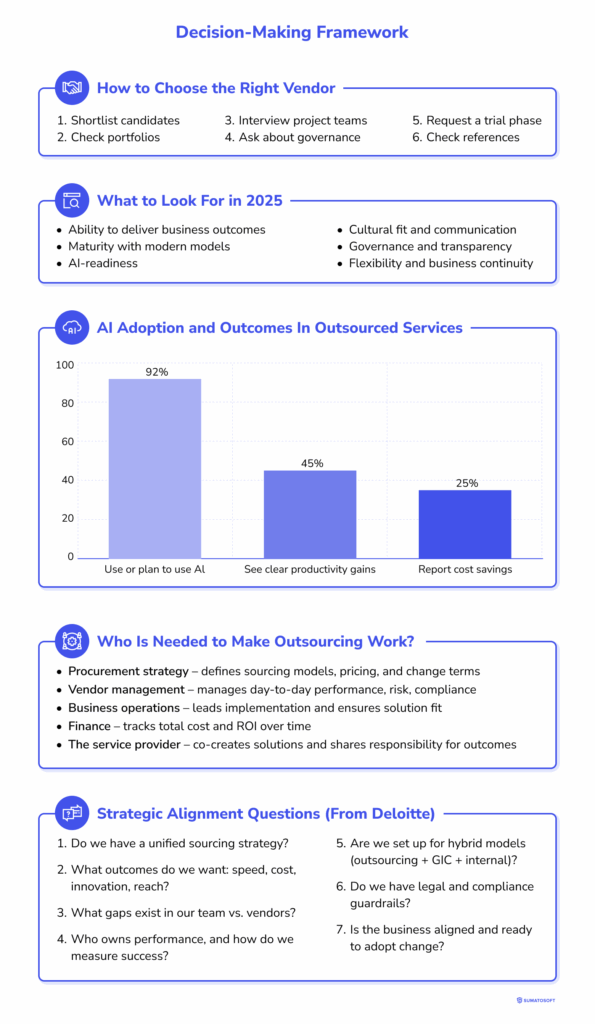
Vendor Vetting: How to Choose the Right Vendor
Outsourcing success depends less on rates – and more on the right partner. In 2025, vendor selection is no longer about choosing the cheapest bidder. It’s about finding a strategic partner who can deliver business outcomes, co-create solutions, and adapt to modern delivery models.
- Shortlist candidates – use trusted platforms (Clutch, referrals, analyst reports).
- Check portfolios – not just logos, but case studies with real outcomes.
- Interview project teams – not just sales reps.
- Ask about governance – how do they handle delays, change requests, scope shifts?
- Request a trial phase – or paid discovery sprint.
- Check references – especially for similar-size projects in your industry.
What to Look For in 2025
- Ability to deliver business outcomes – don’t just evaluate technical skills. Look for vendors who have experience in end-to-end digital transformation, offer pre-built, industry-specific solutions, and can align delivery with your business KPIs.
- Maturity with modern models – the best partners support hybrid contracts: milestone-based, outcome-based, or as-a-service. Rigid T&M or SLA-only vendors often struggle to meet evolving needs.
- AI-readiness – a modern vendor should use AI tools for productivity (automated testing, code generation, CI/CD), offer AI-driven features if needed (e.g., recommendation engines), and be open about where AI is used – and how it benefits the client.
- Cultural fit and communication – alignment on work style, transparency, and collaboration cadence is key – especially in agile projects. Prioritize vendors who are comfortable working across time zones, fluent in English, and proactive in feedback and risk escalation.
- Governance and transparency – trust matters more than ever. Strong vendors will share real delivery metrics (not just activity reports), join you in co-governance – regular retros, escalation paths, shared tools, and be open about pricing logic, subcontractors, and resourcing stability.
- Flexibility and business continuity – can they scale up/down easily? Do they have strong disaster recovery processes, especially for remote or distributed teams?
AI & Maturity
Let’s examine the chart about AI adoption and outcomes in outsourced services.
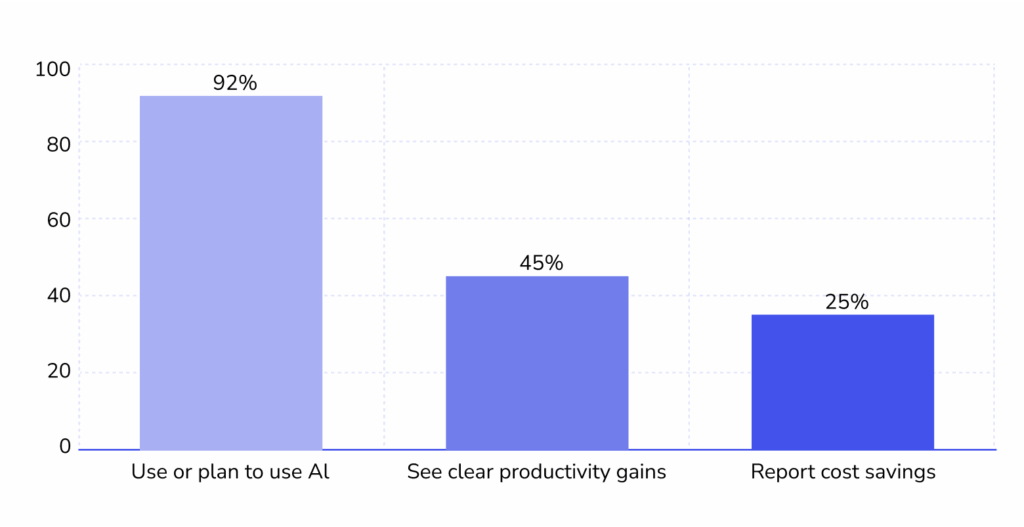
AI tools are everywhere, but not all vendors use them well. According to recent studies, 92% of companies use or plan to use AI in outsourced services, but only ~25% report cost savings from it, and less than half see clear productivity gains. This gap means you should screen for maturity – not just buzzwords. Choose vendors who:
- use AI tools like Copilot, automated QA, or CI/CD intelligently;
- operate under outcome-based contracts that align incentives with delivery speed;
- can co-own AI innovation, if it’s part of your roadmap. AI is a productivity multiplier – but only mature vendors will turn it into client value.
Stakeholder Roles and Responsibilities: Who Owns Success?
Choosing the right vendor is only part of the equation. Delivering business value through outsourcing in 2025 depends on how well your internal teams govern that relationship. According to KPMG’s Future of Outsourcing report, fragmented governance is one of the top reasons outsourcing fails to meet its goals. That’s why mature organizations don’t just pick a vendor – they build a collaborative operating model across all stakeholders involved.
Integrated Governance: The New Standard
In the past, procurement signed the contract, and business units received the service. Today, outsourcing success demands shared ownership across at least five key groups:
- Procurement strategy – develops the sourcing model, pricing structures (e.g., outcome-based or milestone payments), and change management terms. Ensures the contract is aligned with transformation goals.
- Vendor management – acts as the day-to-day liaison with the vendor. Tracks performance, risk, and value realization – not just SLAs. Oversees compliance with data security, recovery, and exit clauses.
- Business operations – defines the functional outcomes and leads the implementation. Brings domain expertise, ensures solution fit, and validates whether the partnership is delivering strategic goals.
- Finance – supports the business case and calculates total cost of ownership (TCO). Tracks ROI and financial performance throughout the vendor relationship.
- The service provider – in modern models, the vendor isn’t just an executor – they’re a partner in planning. Mature providers co-create solutions, participate in governance forums, and share responsibility for outcomes.
Why Role Clarity Matters
Without integrated governance, outsourcing often defaults to:
- transactional performance metrics;
- misalignment between project teams and vendor goals;
- delays in escalation and issue resolution;
- missed opportunities for innovation or process improvements.
But when governance is shared across functions, organizations see:
- faster time to value;
- stronger accountability;
- better risk management;
- resilience to change (e.g., remote shifts, regulatory pressure).
This proactive structure turns outsourcing from a contract into a partnership – and increases the odds of sustainable, strategic impact.
Strategic Alignment Questions (From Deloitte)
Before you move forward, check that your internal strategy is ready:
- Do we have a unified sourcing strategy?
- What outcomes do we want: speed, cost, innovation, reach?
- What gaps exist in our team vs. vendors?
- Who owns performance, and how do we measure success?
- Are we set up for hybrid models (outsourcing + GIC + internal)?
- Do we have legal and compliance guardrails?
- Is the business aligned and ready to adopt change?
Top Web Development Companies to Consider in 2025
1. SumatoSoft – Custom Software with Business Focus

Location: USA, development center in Poland
Why Choose Them:
SumatoSoft specializes in building complex, business-critical web applications with a strong focus on clarity, long-term value, and transparent collaboration. Known for their results-first mindset and experience across industries like logistics, healthcare, and IoT, they offer dedicated teams and end-to-end product development.
2. Toptal – Elite Freelance Network

Location: Global
Why choose them: Toptal connects you with top 3% freelance developers, offering flexibility for short-term or high-stakes web projects. Best for companies that want access to elite talent without committing to long contracts.
3. ELEKS – Enterprise Web and R&D Partner

Location: Ukraine, Poland, US
Why choose them: ELEKS combines technical strength with strong UX, R&D, and data science capabilities. Their large teams support enterprises in finance, logistics, and healthcare.
4. MentorMate – Scalable Teams with Global Delivery

Location: US (HQ), Bulgaria, Sweden, Paraguay
Why choose them: MentorMate provides strategic web development with global teams and deep experience in regulated industries. Strong in healthcare, finance, and education, they offer both full-cycle development and team extension.
5. Intellias – Product Engineering & Digital Consulting

Location: Ukraine, Germany, US
Why choose them: With a consulting-led approach, Intellias supports clients with strategic web platforms, especially in automotive, fintech, and energy.
6. BairesDev – Top Nearshore Talent for North America

Location: Latin America (HQ in San Francisco)
Why choose them: Known for nearshore staff augmentation, BairesDev is a solid fit for U.S. companies looking for time zone alignment and rapid scaling.
7. Cyber-Duck – UX-Focused Development in Regulated Sectors

Location: UK
Why choose them: Cyber-Duck blends robust frontend/backend work with accessibility, compliance, and UX research – ideal for government or healthcare projects in the EU.
8. Django Stars – Python Experts for Complex Platforms

Location: Ukraine
Why choose them: Specializing in Django and Python, Django Stars excels at building secure, scalable platforms – especially in fintech, proptech, and transportation. They’re ideal for startups and scale-ups needing architecture expertise.
9. Moove It (now part of Encora) – High-Quality Nearshore Development

Location: Latin America (Uruguay, Colombia, Mexico)
Why choose them: Now operating as part of Encora, Moove It is known for design-driven development and close collaboration. They serve U.S. clients with nearshore alignment and a boutique approach.
10. Netguru – Digital Acceleration Partner for Scaleups & Enterprises

Location: Poland
Why choose them: Netguru supports clients across banking, retail, and healthtech with agile teams and strong design-engineering collaboration. Their ability to scale quickly and innovate fast makes them a go-to in the EU tech scene.
Templates for Vendor Evaluation
A solid outsourcing decision requires clear comparisons – and structured scoring. These customizable templates help you objectively rank providers based on what matters most to your business.
Scoring Matrix: AI & Outcome-Driven Outsourcing
Use this version if you’re prioritizing innovation, automation, and business impact.
| Criteria | Weight | Vendor A | Vendor B | Vendor C |
|---|---|---|---|---|
| Outcome-Based Delivery Experience | 20% | |||
| AI Services & Automation Readiness | 15% | |||
| Governance & Reporting Maturity | 15% | |||
| Talent Depth & Technical Expertise | 15% | |||
| Cultural Fit & Collaboration | 10% | |||
| Flexible Pricing Models | 10% | |||
| Proven References & Case Studies | 10% | |||
| Innovation & Continuous Improvement | 5% | |||
| Risk Management & Compliance | 5% |
How to use: Score each vendor (1–5), multiply by weight, and sum totals to rank fit.
Scoring Matrix: General-Purpose Vendor Evaluation
Ideal for teams optimizing for reliability, transparency, and delivery track record.
| Evaluation Category | Weight | Vendor A | Vendor B | Vendor C |
|---|---|---|---|---|
| Technical Expertise & Capabilities | 20% | |||
| Security & Compliance Readiness | 15% | |||
| Communication & Cultural Fit | 15% | |||
| Flexibility & Scalability | 10% | |||
| Pricing Transparency & Cost Control | 10% | |||
| Regional Fit & Time Zone Advantage | 5% | |||
| Track Record & References | 10% | |||
| Innovation Contribution | 5% | |||
| Governance & Trustworthiness | 10% |
Tip: Adjust weights based on your priorities – e.g., increase “Compliance” if working with sensitive data.
The Future of Outsourcing Starts Now
Outsourcing in 2025 is no longer a simple binary decision – it’s a strategic design challenge. The old model of “hire offshore to cut costs” has given way to multidimensional sourcing, where companies blend outsourcing, insourcing, automation, and AI to build resilience, speed, and innovation into their core.
What’s Shaping the Future?
- AI-powered delivery – 92% of companies are using or adopting AI in outsourcing; it’s no longer optional – it’s the new baseline for productivity and speed.
- Hybrid sourcing models – organizations are combining outsourcing with Global In-House Centers (GICs), freelance talent, and internal teams to stay agile.
- Outcome-based relationships – vendors aren’t just suppliers – they’re transformation partners; contracts are shifting toward shared goals, measurable results, and innovation accountability.
- Automation & as-a-service expectations – low-code platforms, automation, and “as-a-service” delivery are standard; clients expect faster launches, fewer bugs, and lower overhead.
- Flexible, shorter contracts – rigid 5-year deals are out; milestone-based, 3–5 year, and hybrid pricing models offer more agility and control.
- Strategic nearshoring – regions like Latin America and Eastern Europe are gaining traction – offering better time zone fit, strong tech talent, and increasing geopolitical stability.
Your Next Steps
- Take the templates – grab the framework summary image and scoring matrix to guide your next vendor search.
- Define your project requirements – clarify your goals, scope, timeline, and budget (don’t forget a 10–15% contingency).
- Shortlist smart – use platforms like Clutch, GoodFirms, or referrals to find vendors who fit your stack and values.
- Choose for value, not just price – look for partners who can co-own outcomes, offer transparency, and use AI intentionally.
- Build governance from day one – assign roles, define KPIs, and establish communication protocols before signing the contract.
- Start small – then scale – run a pilot; validate quality and collaboration; then expand with confidence.
Final Word
The companies that will lead the next decade aren’t just outsourcing – they’re designing ecosystems.
Your goal isn’t to “offload tasks.” It’s to build a scalable, adaptive, and innovation-ready delivery engine.
The tools are here. The timing is right. The only question is – what will you build next?
Let’s start
If you have any questions, email us info@sumatosoft.com

